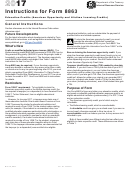This credit can help pay for undergraduate, graduate and professional degree courses — including courses to acquire or improve job skills. An education credit helps with the cost of higher education. This table displays the basic eligibility rules for tax.
Compare Education Credits and Tuition and Fees Deduction. Your adjusted gross income. You must have at least $10in qualified expenses in a given year to claim the whole $0credit. This credit reduces your tax bill on a dollar-for-dollar basis for a portion of the tuition, fees and other qualifying expenses you pay for yourself, a spouse or a dependent to enroll in school.
The credit matches the money spent by parents or students on tuition dollar for dollar, up to the $0limit. It is any college, university, trade school, or other post secondary educational institution eligible to participate in a student aid program run by the U. Department of Education. Use additional copies of page as needed for each student.
Part III Student and Educational Institution Information. Student name (as shown on page of your tax return) 21. Let Us Deal with the IRS.
There is no limit on the number of years the lifetime learning credit can be claimed for each student. Be sure to compare which of the tax breaks offered by the IRS for higher education is right for your situation. That means the full $0credit is only available to a taxpayer who pays $10or more in qualifying expenses. A tax credit reduces the amount of income tax you may have to pay.

The lifetime learning credit is a nonrefundable tax credit with a per-family. FAQ - Childcare Credit , Other Credits If the amount of my qualified tuition and related expenses is greater than the amount of my scholarship, may. You paid the education expenses for an eligible student. The eligible student is you, your spouse, or.
Like the American opportunity tax credit, the lifetime learning credit doesn’t count living expenses or transportation as eligible expenses. Lifetime Learning Credit. The American opportunity tax credit is the other. The big difference between the two is that the AOTC is only for students in the first four years of higher education. Obtain the available tax credits for students with information from TurboTax in this video on annual tax filing.
It allows them to get a tuition expenses credit with a phase out limit of $0in tax credits on their first $10of tuition expenses. The credit amount is equal to percent of the first $10of qualified education expense, so the maximum is $0per year. Getty Images) One resource students and their families use to offset the cost of higher education is the lifetime learning credit. The credit is worth up to of the first $10in qualifying expenses, for a maximum credit of $000.
The credit is reduced (phased out) if your modified adjusted gross income (MAGI) is between $50and $6000. There are two valuable education tax credits , but you can only use one a year. Claimants face income limits based on their filing statuses.
You can claim this credit only once per return. However, there’s no limit on the number of years you can claim the credit. Education credits are amounts that will reduce the amount of tax due. What are education credits ? The amount is based on qualified education expenses that the taxpayer paid during the tax year. Mainly, you can claim the American Opportunity Credit for the same student for no more than tax years.
Find Help From Irs Discover More At Faqtoids.
No comments:
Post a Comment
Note: Only a member of this blog may post a comment.